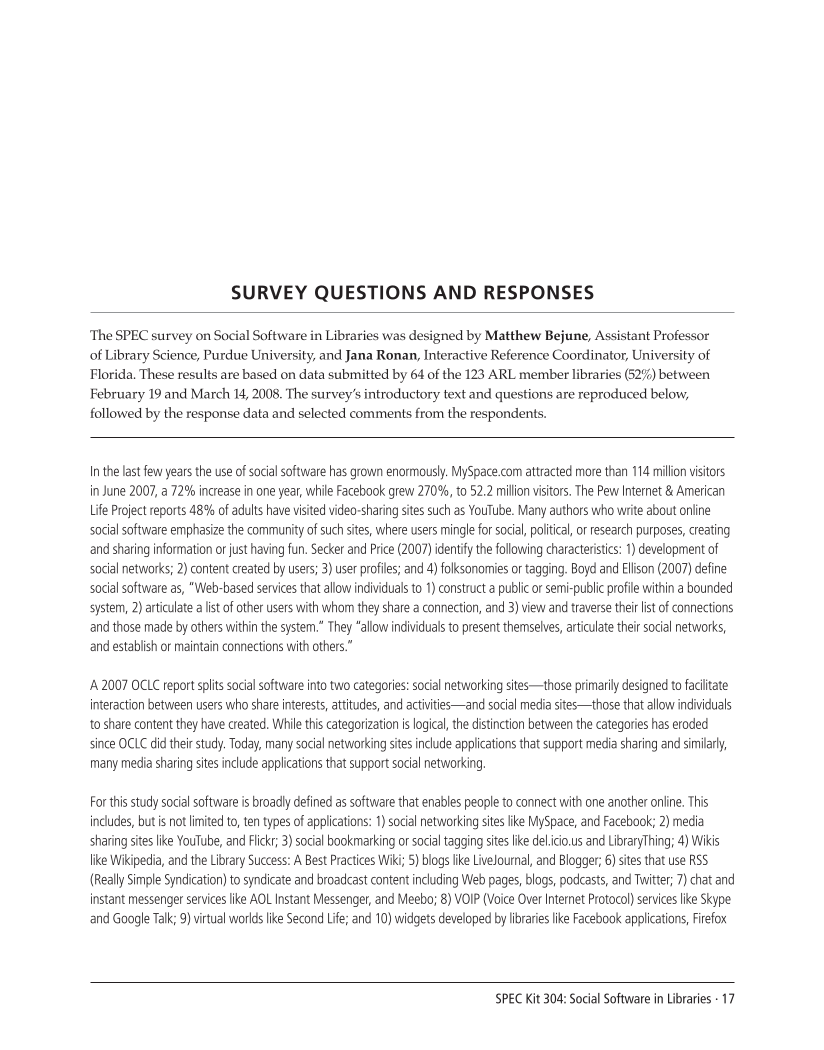SPEC Kit 304: Social Software in Libraries · 17
Survey Questions and Responses
The SPEC survey on Social Software in Libraries was designed by Matthew Bejune, Assistant Professor
of Library Science, Purdue University, and Jana Ronan, Interactive Reference Coordinator, University of
Florida. These results are based on data submitted by 64 of the 123 ARL member libraries (52%) between
February 19 and March 14, 2008. The survey’s introductory text and questions are reproduced below,
followed by the response data and selected comments from the respondents.
In the last few years the use of social software has grown enormously. MySpace.com attracted more than 114 million visitors
in June 2007, a 72% increase in one year, while Facebook grew 270%, to 52.2 million visitors. The Pew Internet &American
Life Project reports 48% of adults have visited video-sharing sites such as YouTube. Many authors who write about online
social software emphasize the community of such sites, where users mingle for social, political, or research purposes, creating
and sharing information or just having fun. Secker and Price (2007) identify the following characteristics: 1) development of
social networks 2) content created by users 3) user profiles and 4) folksonomies or tagging. Boyd and Ellison (2007) define
social software as, “Web-based services that allow individuals to 1) construct a public or semi-public profile within a bounded
system, 2) articulate a list of other users with whom they share a connection, and 3) view and traverse their list of connections
and those made by others within the system.” They “allow individuals to present themselves, articulate their social networks,
and establish or maintain connections with others.”
A 2007 OCLC report splits social software into two categories: social networking sites—those primarily designed to facilitate
interaction between users who share interests, attitudes, and activities—and social media sites—those that allow individuals
to share content they have created. While this categorization is logical, the distinction between the categories has eroded
since OCLC did their study. Today, many social networking sites include applications that support media sharing and similarly,
many media sharing sites include applications that support social networking.
For this study social software is broadly defined as software that enables people to connect with one another online. This
includes, but is not limited to, ten types of applications: 1) social networking sites like MySpace, and Facebook 2) media
sharing sites like YouTube, and Flickr 3) social bookmarking or social tagging sites like del.icio.us and LibraryThing 4) Wikis
like Wikipedia, and the Library Success: A Best Practices Wiki 5) blogs like LiveJournal, and Blogger 6) sites that use RSS
(Really Simple Syndication) to syndicate and broadcast content including Web pages, blogs, podcasts, and Twitter 7) chat and
instant messenger services like AOL Instant Messenger, and Meebo 8) VOIP (Voice Over Internet Protocol) services like Skype
and Google Talk 9) virtual worlds like Second Life and 10) widgets developed by libraries like Facebook applications, Firefox
Survey Questions and Responses
The SPEC survey on Social Software in Libraries was designed by Matthew Bejune, Assistant Professor
of Library Science, Purdue University, and Jana Ronan, Interactive Reference Coordinator, University of
Florida. These results are based on data submitted by 64 of the 123 ARL member libraries (52%) between
February 19 and March 14, 2008. The survey’s introductory text and questions are reproduced below,
followed by the response data and selected comments from the respondents.
In the last few years the use of social software has grown enormously. MySpace.com attracted more than 114 million visitors
in June 2007, a 72% increase in one year, while Facebook grew 270%, to 52.2 million visitors. The Pew Internet &American
Life Project reports 48% of adults have visited video-sharing sites such as YouTube. Many authors who write about online
social software emphasize the community of such sites, where users mingle for social, political, or research purposes, creating
and sharing information or just having fun. Secker and Price (2007) identify the following characteristics: 1) development of
social networks 2) content created by users 3) user profiles and 4) folksonomies or tagging. Boyd and Ellison (2007) define
social software as, “Web-based services that allow individuals to 1) construct a public or semi-public profile within a bounded
system, 2) articulate a list of other users with whom they share a connection, and 3) view and traverse their list of connections
and those made by others within the system.” They “allow individuals to present themselves, articulate their social networks,
and establish or maintain connections with others.”
A 2007 OCLC report splits social software into two categories: social networking sites—those primarily designed to facilitate
interaction between users who share interests, attitudes, and activities—and social media sites—those that allow individuals
to share content they have created. While this categorization is logical, the distinction between the categories has eroded
since OCLC did their study. Today, many social networking sites include applications that support media sharing and similarly,
many media sharing sites include applications that support social networking.
For this study social software is broadly defined as software that enables people to connect with one another online. This
includes, but is not limited to, ten types of applications: 1) social networking sites like MySpace, and Facebook 2) media
sharing sites like YouTube, and Flickr 3) social bookmarking or social tagging sites like del.icio.us and LibraryThing 4) Wikis
like Wikipedia, and the Library Success: A Best Practices Wiki 5) blogs like LiveJournal, and Blogger 6) sites that use RSS
(Really Simple Syndication) to syndicate and broadcast content including Web pages, blogs, podcasts, and Twitter 7) chat and
instant messenger services like AOL Instant Messenger, and Meebo 8) VOIP (Voice Over Internet Protocol) services like Skype
and Google Talk 9) virtual worlds like Second Life and 10) widgets developed by libraries like Facebook applications, Firefox




































































































































































































